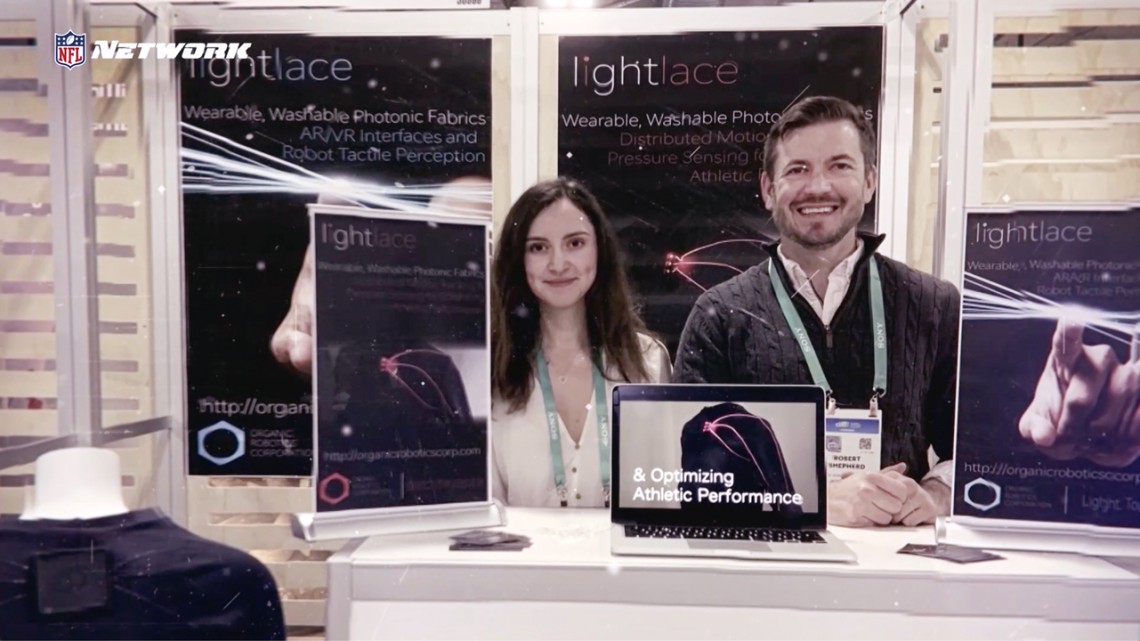
Ilayda Samilgil ’19, left, and Rob Shepherd, associate professor of mechanical engineering, are co-founders of Organic Robotics Corporation, which won the NFL 1st & Future competition Feb. 2 for their Light Lace technology. They are pictured in early January 2020 at the Consumer Electronics Show in Las Vegas. CREDIT: Courtesy of NFL
Score! Engineering startup wins NFL innovation competition
By Tom Fleischman
Growing up in Turkey, the only football Ilayda Samilgil ’19 knew was the kind played mostly with the feet.
“I used to do gymnastics and ice skate,” she said, “but I wasn’t very familiar with some of the most-followed sports here, such as American football or baseball.”
Samilgil’s lack of familiarity served her well as she developed wearable athletic performance-analysis technology in associate professor Rob Shepherd’s Organic Robotics Lab.
Shepherd and Samilgil are now co-founders of Organic Robotics Corporation (ORC), which with its stretchable sensing technology, Light Lace, topped a field of four finalists to win the sixth annual NFL 1st & Future competition, sponsored by the National Football League.
The finals were televised Feb. 2 on the NFL Network, during the runup to the Super Bowl on Feb. 7 in Tampa.
ORC won the $50,000 grand prize in the Innovations portion of the 1st and Future competition; the runner-up team, which took home $25,000, was Genesis Helmet, which is developing a better-performing football helmet focused on the brain rather than the skull.
“This [lack of knowledge] helped me go into this without any personal bias,” said Samilgil, the CEO of ORC, who majored in mechanical engineering and minored in entrepreneurship and innovation. Shepherd is associate professor in the Sibley School of Mechanical and Aerospace Engineering (MAE).
“I was able to learn the needs of athletes and trainers,” Samilgil said, “and adopt [our technology] for their specific-use cases.”
Five winners also were announced in the Computer Vision category; they split a $75,000 prize. The top prize of $25,000 went to Dmytro Poplavskiy from Brisbane, Australia, whose technology uses ultra-high-resolution imagery and data to track and analyze helmet impacts.
Light Lace uses light to measure muscle fatigue and respiration. This stretchable sensor can be integrated into garments or even helmets; the information generated can help athletes and training staff better assess injury risk factors and optimize performance.
Shepherd’s lab has been developing this technology for six years, for an array of other applications: pressure monitoring for diabetes patients, monitoring in-vehicle passenger behavior, improving AR/VR training, and giving robots a sense of touch, among others.
“Each student who’s worked on this has helped march the science toward the simplest engineering solution – using light to quantify touch and gesture – with the most technological benefit,” Shepherd said. “I’ve been blessed with amazing and brilliant students.”
But it was Samilgil, Shepherd said – along with current doctoral student and lab member Hedan Bai ’16 – who thought of applying it to athletic performance. “I’m a big fan of [Samilgil’s] vision for the company,” Shepherd said.
When host Colleen Wolfe announced the results Tuesday night on the prerecorded telecast, Shepherd and Samilgil – who gave their presentation at Cornell Broadcast Studio – were overjoyed and clinked their coffee mugs together in celebration.
“From the beginning, I was confident in our pitch and our technology, but it was a great feeling to hear the results coming from such an expert group of judges,” said Samilgil, who submitted the application for the competition. “It’s a great validation to have at an early stage, and we are now even more motivated to help athletes improve their performance and prevent injuries.”
Samilgil said ORC will put its winnings back into the company, “to employ a great team and start pilot testing our wearable solution.”
ORC, which was founded in 2018, has gotten support from the Praxis Center and the Center for Technology Licensing, both on the Ithaca campus, and from the National Science Foundation’s Upstate New York I-Corps Node.
Other members of the ORC team are: Pallavi Bharoliya, electrical engineer; Tommy Sipple, mechanical engineer; and Kavinkumar Murthi and Matt Kirby, data scientists. Shepherd credited Jenny Leigh Du Puis, a doctoral student in the field of fiber science and apparel design, working with Dr. Huiju Park, and Ryan Bayne ’19 (MAE) with designing the garment used in the competition.
Media Contact
Get Cornell news delivered right to your inbox.
Subscribe
